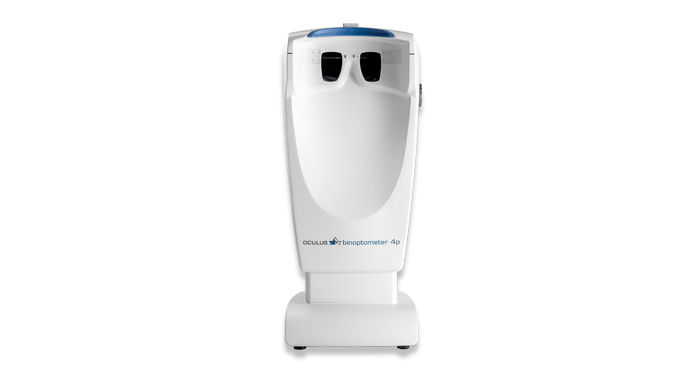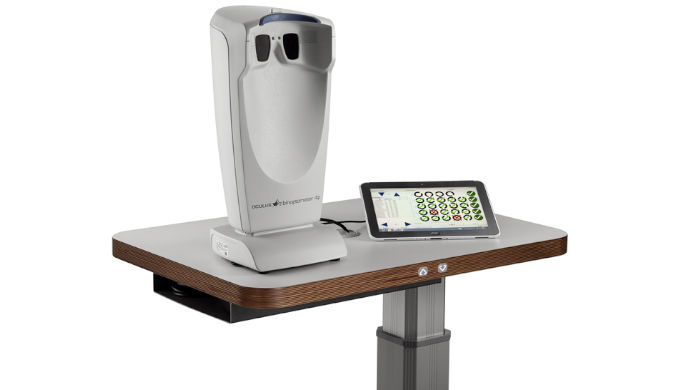Binoptometer 4P
Binoptometer® 4P
Binoptometr 4P przeznaczony jest do szybkiego badania i prawidłowej oceny podstawowych funkcji wzroku. Został zaprojektowany do przesiewowych dla potrzeb : medycyny pracy, optometrystów i lekarzy okulistów.
Główne cechy aparatu:
- płynna regulacja kąta patrzenia pacjenta,
- elektromotoryczna regulacja wysokości (opcja),
- liczne predefiniowane programy badań (dla kierowców, pilotów) z możliwością tworzenia własnych,
- badanie widzenia zmierzchowego i wrażliwości na olśnienie (opcja),
- badanie pryferyjnego pola widzenia (opcja),
- obsługa z panelu sterowania z kolorowym wyświetlaczem dotykowym lub z komputera PC,
- możliwość wydruku wyników badań, a także zapisu do formatu PDF jak i transferu do programu zarządzania danymi,
- mobilność – waga 4,8 – 5,6 kg (zależnie od wersji) pozwala na łatwe przenoszenie aparatu, kufer transportowy (wyposażenie opcjonalne)
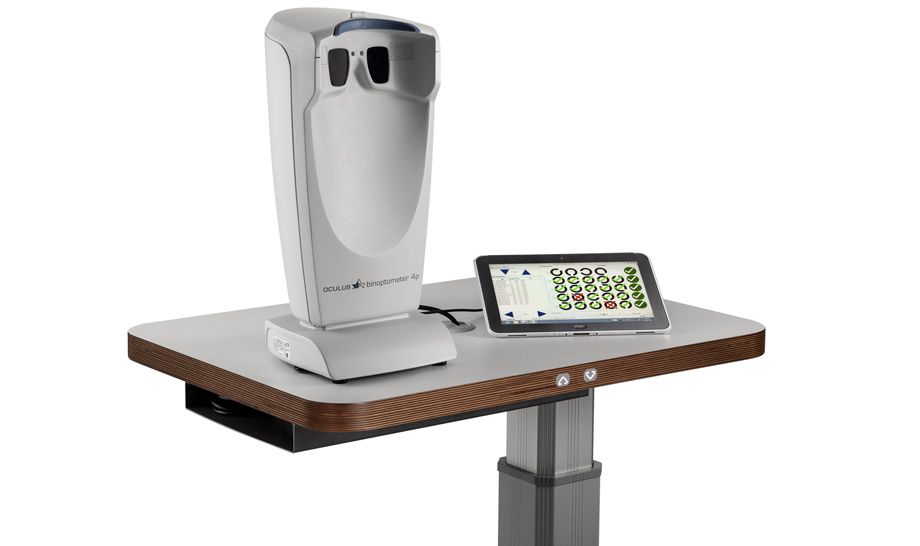
New Test Presentation
Vision tests are presented on a high-resolution micro-color display, allowing a virtually unlimited presentation of vision tests.
Unbeatable
Contrast sensitivity, optional mesopic vision and glare sensitivity testing with just one instrument.
Ergonomic
Convenient height adjustment range of 10.5 cm (4.3 in). In addition, the viewing angle is fully adjustable up to a 35° downgaze, thus enabling testing to be done ergonomically with any eyeglasses.
Visual Acuity Test
With Landolt rings (in acc. with DIN EN ISO 8596), numbers, letters, tumbling E and acuity symbols for children (optional).
New: Now also ETDRS Charts are available for the visual acuity test.
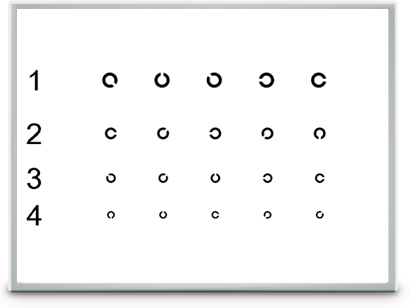
Color Vision Test
Large selection of colour plates according to Ishihara and Velhagen-Broschmann colour test plates. The display is calibrated to the exact colour temperature, thus guaranteeing ideal colour rendering.
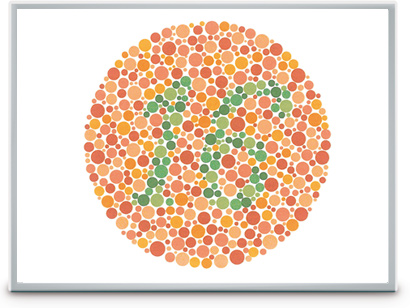
Binocular Test
The binocular vision tests are generated by a modern LCD shutter system, which is very similar to natural visual conditions. Furthermore, a variety of stereo-vision and phoria tests guarantees a reliable evaluation of the binocular vision functions.
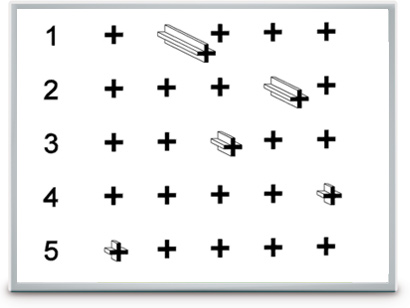
Contrast Sensitivity Test
A program for testing contrast sensitivity under photopic conditions is also integrated. The contrast sensitivity test can be conducted at various visual acuity levels with Landolt rings, letters and numerals as options.
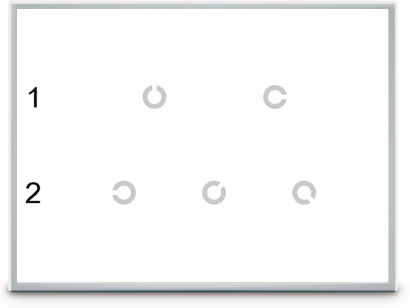
Mesopic Vision and Glare Sensitivity (Optional)
Visual performance varies in different light conditions. To test visual function under mesopic conditions, a Landolt ring is presented in an environment of low light density (0.032 cd/m²), corresponding to the situation of night driving. The Landolt ring (visual acuity level 20/200) is presented in four different contrast stages (1:23 / 1:5 / 1:2.7 / 1:2). Glare sensitivity is tested by simulating the dimmed light of an approaching vehicle. The test with this glare light is also conducted in the four contrast stages.
New: Due to additional corrective lenses in the range of -0.5 D to -3.5 D the possibility to check night myopia is now available.
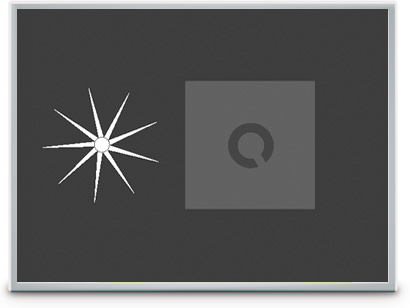
Peripheral Visual Field Test
The visual field is tested at seven visual field locations at the right and at the left. Fixation control is done by means of a changing fixation mark in the center of the test screen.
Additional Corrective Lenses
If asthenopic symptoms are present or if the visual acuity values are abnormal, the additional corrective lenses in the range of +4.5 D to -3.5 D can be used to determine whether an undetected (latent) hyperopia (up to +1.5 D), an age-related long sightedness (presbyopia) or myopia, especially night myopia, exist.
Range of Accommodation Measurement
Measurement of the range of accommodation can be a valuable tool for deciding whether special eyeglasses for computer users are needed. The Duane test figure makes a speedy and informative measurement possible.

Optotypes for Children
In addition to the tumbling-E test, we have added additional optotypes for testing the visual acuity of children. These are based on the H-test optotypes.
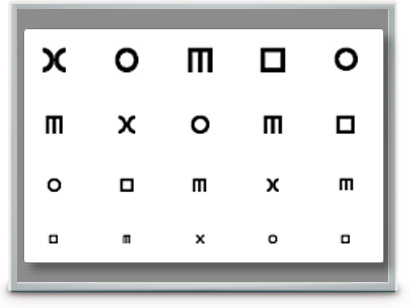
ETDRS Charts
For the visual acuity test the well-known ETDRS charts (based on the Early Treatment Diabetic Retinopathy Study) are now available in the Binoptometer® 4P.
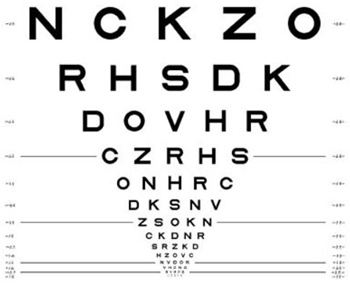
Detailed Printouts
In addition to the already familiar, short results overview, you can now get a more detailed presentation of the results, visual acuity, colour vision test and the Amsler test. Here, you get an overview of all of the answers given by the patient.

Program Editor
- The list of pre-programmed examination programs can be customized according to your requirements. The order of the programs can be changed and examination programs that you don’t need can be hidden.
- Custom programs can be created and existing programs can be copied and edited.
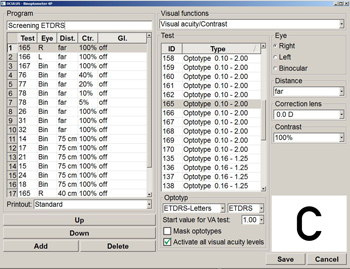
Improved Colour Vision Tests
The instructions for use of the original Ishihara, Velhagen and Matsubara colour chart tests state a time within which a chart should be read. To ensure reliable results, we have now also implemented this recommendation in the Binoptometer® 4P. You have the option to activate this function.
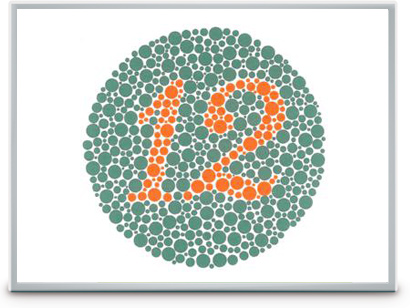
| Brightness of exam field | Approx. 300 cd/m² Equivalent to standard light D 65 (color tests D55) |
| Generation of vision test | Micro color display, 800 x 600 pixels |
| Interface | USB |
| Max. power consumption | 60 VA |
| Voltage | 100 – 240 VAC |
| Frequency | 50 – 60 Hz |
| Weight | Unit with height adjustment: 5.6 kg (12.3 lbs), incl. power cable Unit without height adjustment: 4.8 kg (10.6 lbs), incl. power cable |
| Unit dimensions (W x D x H) | Unit with height adjustment: 224 x 220 x 455 – 560 mm (8.8 x 8.7 x 17.7 – 21.9 in) Unit without height adjustment: 224 x 220 x 455 mm (8.8 x 8.7 x 17.7 in) |
| Recommended computer specifications | Intel® Atom™ Z8350, 32 GB storage, 2 GB RAM, Windows® 10 |

